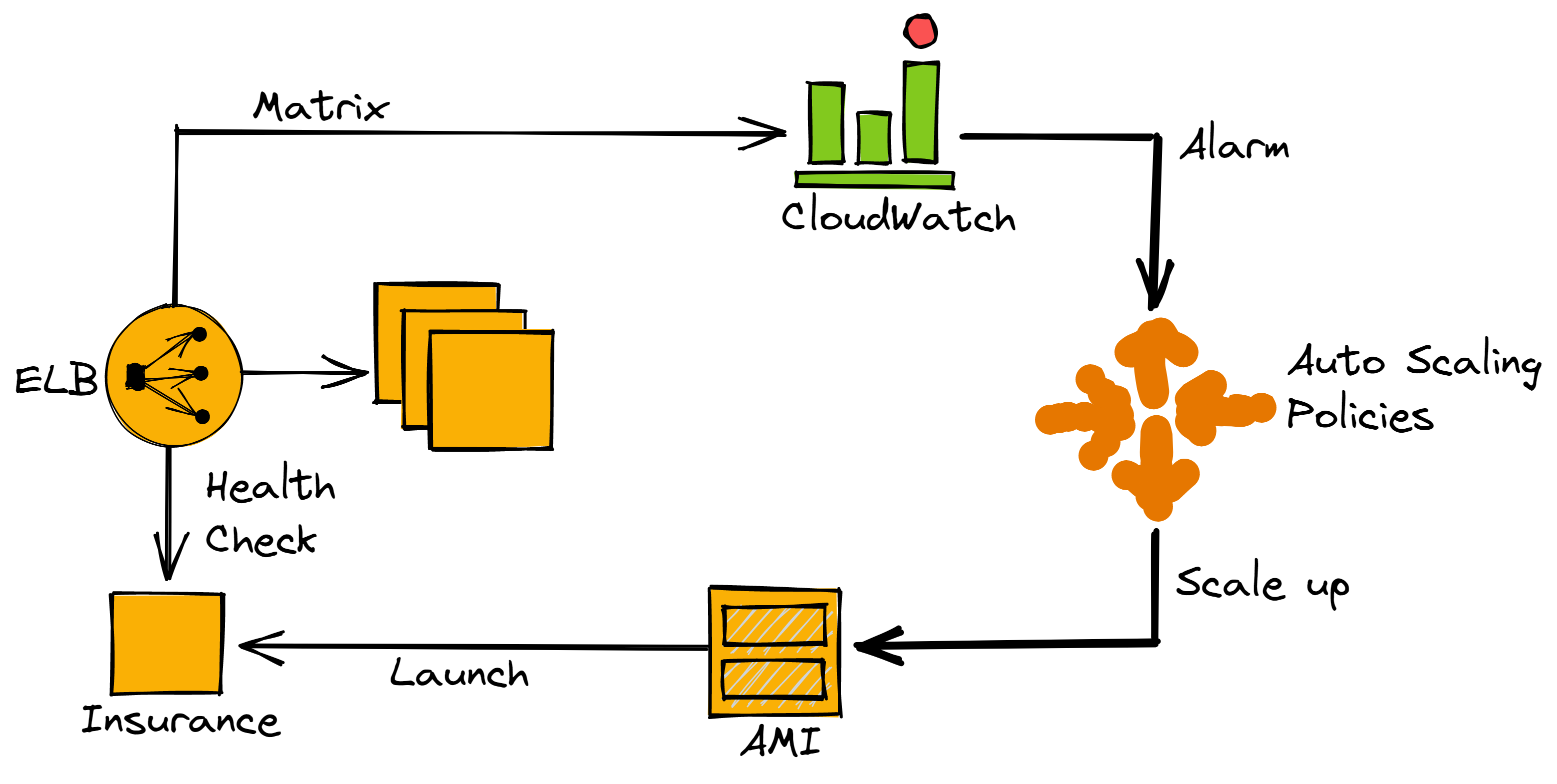AWS-ASG (Amazon Auto-Scaling Group)
An Amazon Auto-Scaling Group (ASG) is a logical group of Amazon EC2 instances with identical features. ASG is a cloud services technology that allows for the appropriate allocation of computational resources. Every Amazon EC2 instance in the group must adhere to auto-scaling policies. The number of occurrences in ASG is used to calculate the size of ASG. It's also known as auto-scaling or automated scaling. As a user's needs change, the number of active servers will also change automatically depending on the demand on the group servers.
The ASG is widely used to monitor applications and automatically adjust capacity to maintain a steady and predictable performance at the lowest possible cost. It also makes it easy to set up application scaling.
Auto-Scaling in Cloud Computing

Auto-scaling is a feature of cloud computing that helps organizations scale the capacity of cloud services or virtual machines up or down based on traffic levels. Amazon Web Services (AWS), Microsoft Azure, and Google Cloud Platform (GCP) are the cloud computing components that provide the auto-scaling feature.
By automatically expanding and lowering fresh instances as demand rises and falls, auto-scaling reduces cost and enables consistent functionality. As a result, amidst changing and often unforeseen requests for services, auto-scaling ensures stability. Auto-scaling also avoids the need to react explicitly to heavy traffic in real-time which would necessitate more tools and instances. Furthermore, auto-scaling allows for the installation, tracking, and deactivation of each unit.
Best Practices:
Let's pretend that you have a mobile or web application that operates using two instances. You want the auto-scaling group's CPU utilization to remain around 50% whenever the workload on the app varies. Although you can't anticipate when the parameters will alter, this strategy is beneficial for scaling in reaction to such changes. AWS EC2 auto-scaling can be configured to reply for you. Smarter auto-scaling settings and better audit evidence of auto-scaling parameters can often help a platform respond rapidly to this concern.
Several programs, such as auto-scaling in Azure, have a learning curve that is taken care of by AWS auto-scaling groups, which allow users to categorize instances in a structured group which enables easier scaling and control.
However, in practice, the ideal usage for AWS auto-scaling groups is in combination with request instances that fit the stored instances you've purchased. By doing this, you can save maximum money when compared to other service providers.
Are you sure you're getting this? Is this statement true or false?
Auto-scaling and load-balancing are related since an application typically scales based on load balancing serving capacity.
Press true if you believe the statement is correct, or false otherwise.
Try this exercise. Click the correct answer from the options.
Auto-scaling group size is determined by the __________ in the auto-scaling group.
Click the option that best answers the question.
- Time period
- Number of items
- Number of instances
- None of above
Terminology
A particular server or system subject to auto-scaling policies set for a cluster of workstations is referred to as an instance. A group is an auto-scaling group when each instance follows auto-scaling policies. The Elastic Compute Cloud (EC2), for example, is the Amazon ecosystem's computing engine. Inside the Cloud platform, EC2 data centers provide versatile and customized server alternatives. EC2 services are virtualized, dynamically scaled, and presented to the consumer as a single entity.

Group size:
The quantity of instances inside an ASG is known as the ASG group size. The optimal amount of data in such an ASG platform is called the desired capacity, or size. If such two quantities vary, the auto-scaling group could either create (provide and connect) additional instances or delete (detach and end) existing ones.
Cut-offs:
Small and large size cut-off values specify cut-off points over and under which instance availability may not fluctuate. These cut-offs are based on the criteria and auto-scaling techniques regulating a given ASG platform. An auto-scaling policy frequently defines any adjustments to that same auto-scaling group's proposed solutions when measurements break established thresholds.
Cool-down:
Cool-down times are frequently coupled with auto-scaling strategies to guarantee that the overall structure is able to control traffic. After these scaling activities, ASG cool-down periods create time for the newly formed instances to continue managing traffic. Constant or gradual changes to the desired capability of an ASG are possible. However, instead of providing a final value, gradual modifications increase or decrease by a certain amount. Strategies that scale up (also known as scale-out policies) and policies that are scaled-down (also known as scale-in policies) reduce the necessary capacity.
Health Check:
Auto-scaling groups do health checks on associated instances to make sure they're operating correctly. Instances that aren't healthy should be replaced. A health survey can be performed using elastic load balancing tools. Configurable health checks, as well as EC2 health checks, are available. A satisfactory health inspection can be predicated on whether or not the instance is continuously accessible and functioning in its connected load balancer.
Programs and variables are necessary to introduce a new instance. They are described in the launch setup covering the instance class system image, probable launch zones, and payment choices (such as PayPal).
Settings:
Select the Identical Zone when you build the launch pattern from the notification center at the top front of the display; an auto-scaling group is an option. Provide a name for your ASG profile on the Choose Launch template or settings page for the ASG group label.
Features
Auto-search of resources:
AWS auto-scaling searches the user's environment and automatically identifies the adaptable cloud resources that underpin your service. By doing so, users don't have to search different service APIs to find them individually.
Scaling techniques:
Users can use AWS auto-scaling to choose between three predetermined optimized options to enhance efficiency, lower costs, or manage the two. Users can also define their personal resource use objective if they wish. Amazon ASG will build scaling rules for each of your selected resources based on your chosen scaling approach.
Smart Scaling Decisions:
Predictive scaling forecasts anticipated traffic, particularly periodic surges, and allocates the appropriate proportion of EC2 instances ahead of time. Machine learning methods in predictive scaling recognize variations in daily and weekly routines and proactively update projections. Scaling strategies on Amazon are self-optimizing, so they learn the user's actual demand behaviors to reduce resource volume variations.

Let's test your knowledge. Is this statement true or false?
Auto-scaling is not a cloud computing feature that enables organizations to scale cloud services.
Press true if you believe the statement is correct, or false otherwise.
Let's test your knowledge. Click the correct answer from the options.
Auto Scaling Group is used to ________.
Click the option that best answers the question.
- Manage to scale of multiple resources
- Define dynamic scaling policies
- To scale cloud services
- All of above
Benefits
Fast scaling:
As a simple and straightforward interface, AWS ASG allows you to establish utilization values for numerous resources. Without switching between consoles, you can instantly observe the overall utilization of all your scaled resources. For example, if your application relies on AWS EC2 and DynamoDB, the user can use auto-scaling to handle resource allocation across all EC2 instances.
Pay only for what you use:
While using services, AWS auto-scaling can help you optimize your utilization and cost savings since you only spend on the tools you need. AWS ASG seamlessly eliminates any available surplus resources whenever demand drops which prevents you from overpaying.
One Pager Cheat Sheet
- AWS Auto-Scaling Group (ASG) is a cloud services technology that automatically adjusts capacity to maintain a steady performance at the lowest cost.
- Auto-scaling allows
cloud computingservices like Amazon Web Services (AWS), Microsoft Azure, and Google Cloud Platform (GCP) to adjust their capacity based on traffic levels, improving stability, performance, and cost savings. - Auto-scaling and
load-balancingare related features of cloud computing which ensure that services and virtual machines are using their resources efficiently and remain stable in response to traffic changes. Auto-scalingdynamically adjusts the number of instances in anauto-scaling groupin order to maintain a desired level of performance and the correct group size.- An instance within an auto-scaling group follows pre-defined auto-scaling policies to adjust its group size, cut-off values, and
cool-downperiod, which is regulated byhealth checks, and configured through alaunch setupcontaining settings. - AWS Auto-Scaling provides an
auto-searchof resources and allows users to choose between threescaling techniquesas well as define their own objectives and leverage predictive scaling and self-optimizing methods to manage and lower costs. - AWS
Auto-Scalingis an invaluable tool that offers features such as auto-search, scaling techniques, and predictive scaling, to help organizations optimize and manage their cloud resources to maximize cloud service performance. - Auto Scaling Group helps organizations to respond quickly to changing conditions and manage their resources efficiently, ensuring their applications are running the required number of instances without overspending.
- AWS ASG enables
fast scalingandcost savingswith its simple and straightforward interface, allowing users to easily handle resource allocation and optimize utilization.

